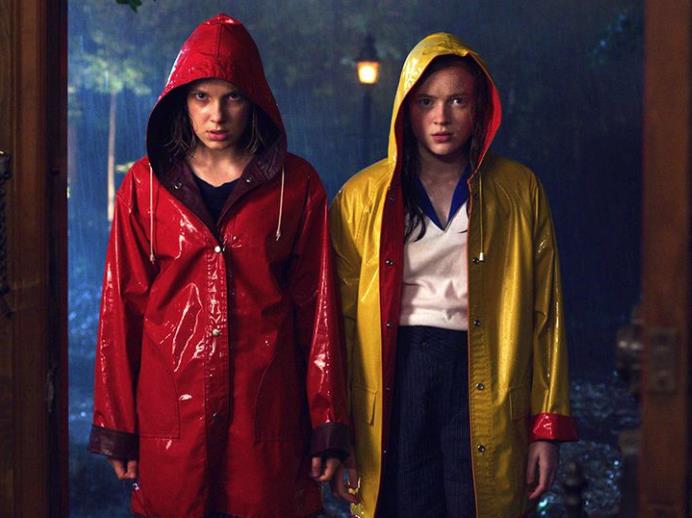Image: Stranger Things in stormy weather. Via Netflix.
On Wednesday July 17, some financial analysts were hopeful about Netflix in the market, even though share prices only gained 4% in the last six months.
According to CNBC investors would keep their nerve if subscriptions grew by ‘300,000 U.S. additions [and] 4.7 million international additions’.
Cash flow expenditure needed to stay at or under US$3.5b. The company needs a continuing flow of excellent content with first class names. In June Netflix broke with its tradition of pathological secrecy to reveal that Murder Mystery was its biggest weekend opener ever with 30.8 million views in three days. It needs to encourage market confidence.
More than half came from outside the US. Latest total membership figures come from April, showing a total of 150 million around the world with 60 million in the US. The company is getting five new signups overseas for every one in North America.
How to worry the market
By the end of the same day, the world was looking much grimmer for the feisty disruptor. The company lost 100,000 subscribers in the US and only added 2.7 million globally. This is even worse than it looks because the annual figures are pretty good. Global membership is up by 21.9%.
Revenue for the quarter is a tad under US$5 billion. Over the year Netflix still expects to lose US$3.5 billion, which it has long said will be the peak year for losses. 2020 is supposed to improve, even though key programs The Office and Friends are on the way out. Ever optimistic the company believes those losses will provide more money to commission its own shows. It blames the drop on the surge of memberships in the previous three months and admitted some poor choices in commissioning.
The slate problem
Building the slate is probably the most terrifying activity of any substantial company in entertainment. Netflix claims its datasets and algorithms will ensure success, but that hasn’t worked over the last year. What is more, the demand for good shows made by prime people with just enough originality to keep them fresh may simply be too large for the available production community.
Worse, the taste of audiences varies with the zeitgeist. Is dystopia dying? What about the solitary hero? As creators learn more about their specific audiences, key markets like older women might peel off to brands designed for them. This is the way that conventional cable works, which creates specialist channels but then aggregates them into the one linked service and profit structure.
In the next couple of years, Netflix will lose access to any Disney shows it has, anything from HBO, and from MSNBC. The sector is balkanising back into its constituent parts and the battle will depend hugely on rights for existing shows and franchises so providers can stay out of the the Big N’s debt escalator.
The fragmentation has many implications. Netflix itself will be under pressure. No-one will have access to everything. The potential subscriber ceilings will decrease.
The keys to Netflix’s future
Here’s more speculations which are worth thinking about:
1. The regulatory model that Australia is thinking about suggests that 10% of revenue has to be spent on local programming. If a large number of companies get a toehold and no-one dominates, the expenditure on Australian programs will be split into smaller pieces. No-one gets enough to do well.
2. The indications are that audiences don’t really like programs to be interrupted by ads. That is a hidden advantage for the blue chip providers like Netflix. Smaller players will need a mixed subscription and advertising model, giving the big providers an advantage. Enough to offset advertising? Maybe everyone will come back to a model which works off base subscriptions + ad-less premiums + ads + sponsorship + product placement.
3. Traditional television links light entertainment, sport, drama and news/current affairs. The new services do not do news, or at least only in a very basic transnational way.
4. The cost of entry for a subscription streaming service is actually very low compared to the historical cost of setting up a network.
5. Asian services are coming too. China and India have titanic capacity; the question is just what they do with it at a time when they are both led by puritanical, censorious leaders.
6. Demand is climbing, but budgets may have to drop.
The game is global and these factors suggest it is very unstable. Even on a local level the market is unpredictable. Foxtel Presto collapsed, but the new Kayo service is very clever. Stan is still proudly in the market. SBS is growing its movie output. CBS is supposed to use Ten as a streaming springboard.
In the short term, all of this means that providers are in business for sticky shows, that can start with a short first season and then run for years. In the longer term, all of this means the sector should expect the party will soon be over. The really smart producers might be doing deals in Asia where the market is still very underdone and much more elastic.
Netflix Chief Content Officer Ted Sarandoz gave an investor interview about the state of play.





